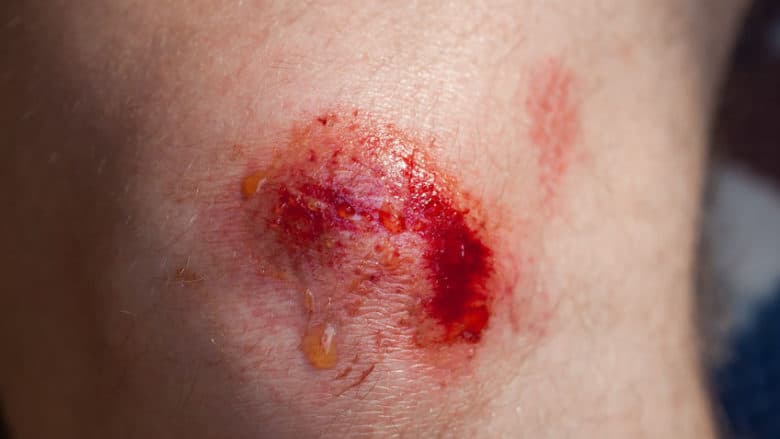
Cuts and scrapes begin healing faster than a nanosecond after injury. How you care for them in this early period can either harm or support your natural healing. Unfortunately, many use methods that harm the healing process — like using soap, hydrogen peroxide, iodine, or alcohol.
I did too until my research found the “best treatment” for cuts and scrapes. For instance, soap, hydrogen peroxide, alcohol, and iodine can irritate the wound further damaging the cells; and use of antibiotic ointments risk bacterial resistance, allergic response, and contact dermatitis that can slow healing.
Moreover, taking nonsteroidal anti-inflammatory drugs like ibuprofen (Advil) can interfere with healing, as they stop inflammation, the first phase of the healing process.
The best treatment uses a holistic approach: body mind and spirit. It works with, not against, natural wound healing.
Steps for Natural Healing
- Take a few deep breaths and send love to the area. You can also send healing energy to the area by using methods like Reiki, Therapeutic Touch, or creative visualization.
- Clean the wound with cool water. Hold it under running water or pour water over the wound. Some bleeding is normal and helps clean the wound. Most small cuts or scrapes will stop bleeding in a short time.If you need to stop the bleeding, apply firm but gentle pressure on the cut with a clean cloth, tissue, or gauze for up to 20 minutes (If it soaks through, place more on top without removing the layer beneath).Raising the injured area above your heart also slows bleeding.
- Wash the skin around the wound with a soft soapy washcloth (avoid getting it in the wound as it can cause irritation).
- Carefully remove any dirt that remains in the wound after cleaning with tweezers that have been soaked in rubbing alcohol.
- If the wound is in an area that isn’t likely to get dirty or disturbed by clothing leave it uncovered as the air will help it stay dry and heal.If you need to cover the wound, use a Band-Aid type adhesive strip or sterile gauze with tape. Change it at least daily and more often if needed to keep it dry (moisture can breed bacteria).Although some doctors recommend using a thin layer of antibiotic ointment on the wound to reduce infection and prevent scarring, others say that these ointments don’t make the wound heal faster and risk antibiotic resistance and allergic reaction. If you do use an antibiotic ointment and a rash appears, stop using it.
- Repeat sending love or healing energy to the area as often as needed.
- Do not pick at or remove scabs. Scabs form to protect the wound as a part of the healing process. Allow them to fall off naturally.
When to See Your Health Provider
Deep or complicated wounds may be difficult to clean or involve major blood vessels, nerves, ligaments, and/or tendons. See a doctor if you can’t get all the dirt out and if the wound is deep, covers a large area, or excessive bleeding occurs. Also let them know if you feel numbness in the area or if you have problems moving an involved extremity.
Later, let your doctor know if the wound isn’t healing properly or signs of infection occurs. Here are some specific indications for when to call your doctor from the familydoctor.org editorial staff:
- The wound is jagged
- The wound is on your face
- The edges of the cut gape open
- The cut has dirt in it that won’t come out
- The cut becomes tender or inflamed
- The cut drains a thick, creamy, grayish fluid
- You start to run a temperature over 100°F
- The area around the wound feels numb
- You can’t move comfortably
- Red streaks form near the wound
- It’s a puncture wound or a deep cut and you haven’t had a tetanus shot in the past 5 years
- The cut bleeds in spurts, blood soaks through the bandage or the bleeding doesn’t stop after 20 minutes of firm, direct pressure
Key Points
The initial care given to cuts and scrapes can harm or support natural wound healing.
Use these 7 steps to give your cuts and scrapes the best support for their natural healing.
Sources and Resources
Family Doctor.org, “Cut, Scrapes, and Stitches,” December, 2010, http://familydoctor.org/online/famdocen/home/healthy/firstaid/after-injury/041.html.
Mayo Clinic, “Cuts and Scrapes: First Aid, November, 2009, http://www.mayoclinic.com/health/first-aid-cuts/FA00042.
Moore, Nancy, The Cure for Chronic Pain: End the Pain of Arthritis, Sports Injury, and Other Joint Problems (Peoria, AZ: Intermedia, 2009).
